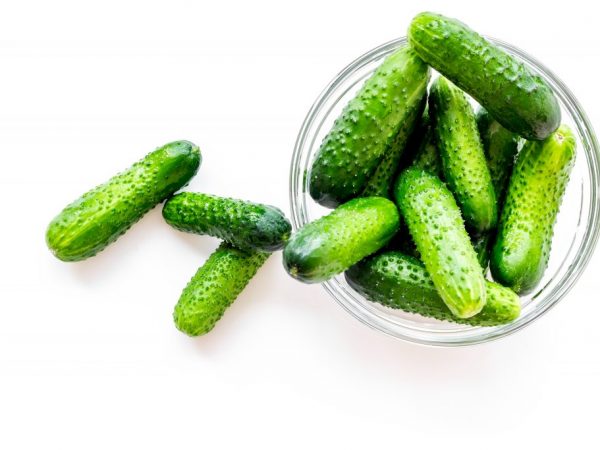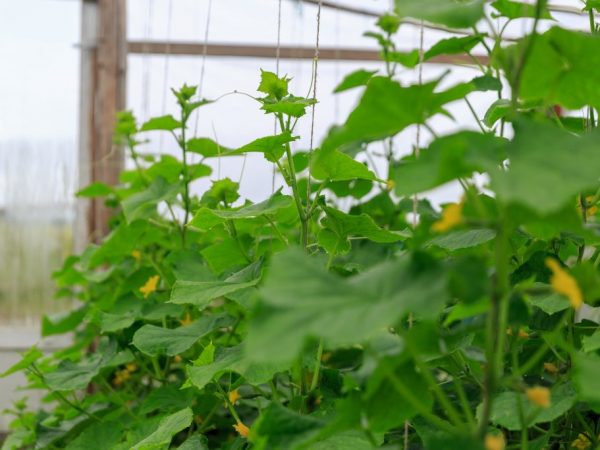Characteristics of the Claudia cucumber
The popular Claudia cucumber variety is an early ripening hybrid. Cucumbers are grown in greenhouse conditions or at home on the balcony, if the gardener creates suitable conditions.

Characteristics of the Claudia cucumber
A short-fruited hybrid gives a good harvest: the bushes require minimal maintenance. Grown cucumbers are used to make delicious salads and marinades for the winter.
Hybrid characteristics
Variety f1 - parthenocarpic hybrid: weakly branched bushes with female flowering. The pubescence has an average density, while the fruit has a juicy, dense, sweet pulp. The f1 variety is an early crop and yields 40 days after the seedlings are planted. At one node, 2-3 ovaries are born at once - the fertility of the bush is the greatest advantage of the hybrid.
Seedling seeds are small, cultivated: it will not be possible to remove seedlings from cucumbers on their own, otherwise the hybrid will lose its basic properties. The f1 variety allows you to harvest 10 kg from 1 m2 of plantings.
Description of fruits
Claudia cucumbers grow in relatively warm temperatures and need minimal watering. Description of cucumbers:
- short-necked cucumber;
- medium lumpy;
- length from 8 to 10 cm;
- weight from 70 to 80 g;
- the mass of gherkins is from 30 to 50 g.
Cucumbers have a relatively smooth surface with small light spines. The mass of one cucumber is 60 g, depending on the intensity of watering during the period of active growth.
Fruits on small bushes of elongated cylindrical shape (the length of one cucumber does not exceed 6 cm).
Description of the bush
The growth of the main stem is not limited to the flower cluster. The main stem is formed on its own without the help of a gardener: all the juices of the bush are used to feed the stem.
Description of the leaves of the bush:
- rounded and wide;
- deep green color;
- medium size;
- dense (with 2-5 ovaries in each leaf sinus).
Seeds are harvested a few weeks before planting seedlings: they are treated with antifungal drugs. Such actions allow the seedlings to start growing rapidly. Cucumber bushes are thick and resistant to sudden changes in temperature.
The number of cucumbers directly depends on the thickness of the main stem and the number of full-fledged ovaries. The hybrid is growing in 7 regions of Russia: northern and central.
Benefits
Claudia hybrid is resistant to drought and low humidity. Good resistance of the variety to fungal diseases and powdery mildew. If the hybrid is planted on the balcony, the bushes are small with a thick stem and thin leaves.
A versatile culinary hybrid: Cucumbers are eaten raw and pickled. For salting, Claudia is the best option. The juicy fruits endure a long journey and are ready for transportation immediately after harvest.
The variety is included in the Russian register as a hybrid for growing in greenhouse conditions (under a film cover in the open field).The advantages of the plant include self-pollination of inflorescences, which eliminates the presence of bees - in a greenhouse you do not have to worry about the development of ovaries. In thickened plantings, a wide stem gives a stable yield: the bushes endure a prolonged absence of sunlight and a minimum amount of nutrients in the soil.
disadvantages

This variety does not tolerate moisture at all.
The main disadvantage of cucumbers, which are suitable for pickling and eating raw, is the cost of the seeds. Homemade cucumber for seeds is not grown: the seeds are not suitable for planting on open ground.
The number of cucumbers pays for the cost of the seeds The F1 variety does not get along well in regions with frequent rains: an increased amount of moisture is detrimental to the fruit.
Landing features
Planting is done in two ways: by sowing seeds in a garden bed or by planting grown seedlings. In the first case, the culture is planted on fertilized and moist soil: the seeds are unstable to low temperatures.
Seedlings are stronger and more resilient, which leads to higher productivity. If the seedlings are transplanted correctly and the root system is not damaged, the seedlings start to grow rapidly: the stem is formed and the first ovaries appear.
Growing rules
The characteristic of the variety says that the optimum temperature for planting seedlings is 16 ° C. The temperature is measured at a depth of at least 10 cm (the level of planting of the root system). Seedlings and seeds are planted in an ordinary way (along or across).
Proper cultivation says that peat or fertilizer with peat is used for mulching the beds (fertilizer layer 2-3 cm). After planting the seeds, the bed is covered with a film until the seedlings appear, this will strengthen the sprouts and therefore increase the yield. There is no need to water the seeds, and the seedlings are watered for the 2nd week of active growth. The seedlings are watered with warm water (25 ° C). Seedlings are fed with urea and potassium chloride.
Planting seeds
Seeds in open ground are not protected from fungal diseases, and therefore cultivation in such conditions requires special attention. The process of planting a seedling in the garden includes seed treatment - soaking them will increase the stability of future seedlings. Seeds before planting:
- are selected by size (there should be no damage or stains on the seeds);
- hardened (processed in whey or a commercial solution that kills fungal spores);
- warm up.
If you harden the rasskada well, and feed the Claudia cucumber before planting, its yield will increase several times. After the formation of rows, a mound is made of fertile soil (about 15 cm). It will allow the bushes to grow quickly and bear fruit well for 40 days.
Before planting, a suitable place is selected in the garden: cucumbers are planted after potatoes or tomatoes. After root crops, planting a hybrid is undesirable (the predecessor of cucumbers depletes the soil).
Transplanting
On the 25th day, the seedlings are carefully transplanted to open ground (planting in the garden is carried out in late spring, when the ground is completely warmed up). The sown seedlings in early May will start to grow rapidly and at the end of June the gardener will harvest the first healthy harvest.
For the best agro hybrids, the shady side of the garden is chosen, in which water does not collect after rains. The garden should not be fully illuminated by the sun, otherwise the seedlings will quickly lose moisture. The Claudia hybrid does not take up much space, the bushes can grow in cramped conditions in a greenhouse (growth occurs one stem at a time).
Growing on the balcony
Cucumber Claudia f1 is planted on a balcony or in a greenhouse: dense bushes do not take up much free space. For models outdoors, it is necessary to create additional conditions: fertilize the soil and saturate it with moisture. The Russian Siberian hybrid does not need frequent watering, so the next watering after planting is carried out in 2 weeks.Seedlings are planted in a greenhouse in early April and by summer the gardener can harvest the first crop.
It is not advisable to repot seedlings often - due to damage to the root system, the resistance of the bush to diseases and adverse environmental conditions may deteriorate. A seedling (Claudia f1 cucumber) grows well in a peat pot.


